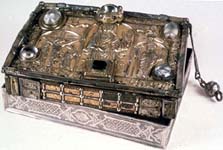
The "Cathach
of St. Columba." |

|

The "Cathach
of St. Columba." |

|
The manuscript is in poor condition. Fifty-eight leaves survive. This manuscript introduces two decorative forms which will become staples of Insular manuscript decoration. First, the decorations of initials which actually alter the form of the initial, rather than just filling in spaces, and the diminution of letters at the beginning of a section, in which the enlarged initial is followed by letters which become successively smaller until they match the size of the text (also called diminuendo.)(Alexander, cat. Entries 4 and 5.) This diminution pulls the initial into the script, instead of leaving it standing apart. As Nordenfalk describes them, the initials "are conceived as elastic forms expanding and contracting with a pulsating rhythm,"(13). The initialsí designs indicated the preference of Insular artists for traditional Celtic design over the Late Antique. (Nordenfalk, 13-14.) The illumination consists of around 60 initials at the beginning of each Psalm. The decorations include trumpet, spiral, and guilloche shapes. (A guilloche shape is "a design in which two or more curved lines or bands are interwoven, forming a series of spaces in between them," according to the New World Dictionary.) The tail of an initial Q turns into a fish. Other initials have flourishes which resemble abstract bird heads.
The cathach is traditionally
associated with St. Columba, who is alleged to have copied it himself. It was
enshrined in a cumdach, which was carried into battle as a talisman to gain
victory; "cathach" means "battler." When the shrine was opened in 1813, the
Psalter was discovered. Like the Codex Usserianus Primus, it was considered
a relic. Calkins suggests that the decorated letters' "motifs have no
direct resemblance to those appearing in the Durrow illuminations." (Calkins,
32.) This statement ignores the clearly zoomorphic flourishes of the letters,
resemblling faces or fish.
Bibliography: